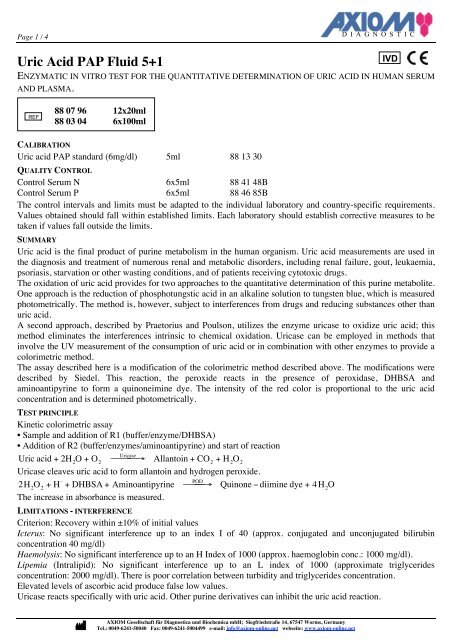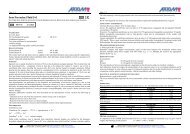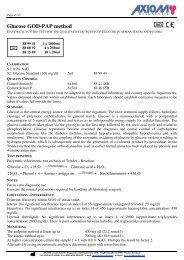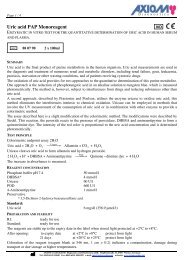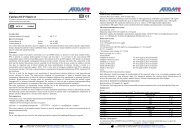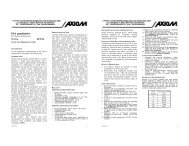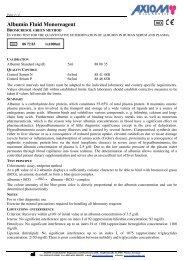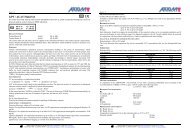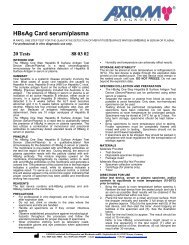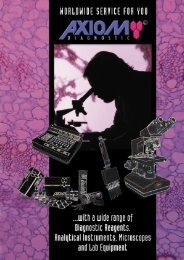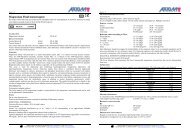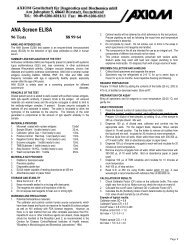Uric Acid PAP Fluid 5+1 - AXIOM Solutions
Uric Acid PAP Fluid 5+1 - AXIOM Solutions
Uric Acid PAP Fluid 5+1 - AXIOM Solutions
You also want an ePaper? Increase the reach of your titles
YUMPU automatically turns print PDFs into web optimized ePapers that Google loves.
Page 1 / 4<br />
D I A G N O S T I C<br />
<strong>Uric</strong> <strong>Acid</strong> <strong>PAP</strong> <strong>Fluid</strong> <strong>5+1</strong><br />
ENZYMATIC IN VITRO TEST FOR THE QUANTITATIVE DETERMINATION OF URIC ACID IN HUMAN SERUM<br />
AND PLASMA.<br />
REF<br />
RE<br />
88 07 96 12x20ml<br />
88 03 04 6x100ml<br />
F<br />
CALIBRATION<br />
<strong>Uric</strong> acid <strong>PAP</strong> standard (6mg/dl) 5ml 88 13 30<br />
QUALITY CONTROL<br />
Control Serum N 6x5ml 88 41 48B<br />
Control Serum P 6x5ml 88 46 85B<br />
The control intervals and limits must be adapted to the individual laboratory and country-specific requirements.<br />
Values obtained should fall within established limits. Each laboratory should establish corrective measures to be<br />
taken if values fall outside the limits.<br />
SUMMARY<br />
<strong>Uric</strong> acid is the final product of purine metabolism in the human organism. <strong>Uric</strong> acid measurements are used in<br />
the diagnosis and treatment of numerous renal and metabolic disorders, including renal failure, gout, leukaemia,<br />
psoriasis, starvation or other wasting conditions, and of patients receiving cytotoxic drugs.<br />
The oxidation of uric acid provides for two approaches to the quantitative determination of this purine metabolite.<br />
One approach is the reduction of phosphotungstic acid in an alkaline solution to tungsten blue, which is measured<br />
photometrically. The method is, however, subject to interferences from drugs and reducing substances other than<br />
uric acid.<br />
A second approach, described by Praetorius and Poulson, utilizes the enzyme uricase to oxidize uric acid; this<br />
method eliminates the interferences intrinsic to chemical oxidation. <strong>Uric</strong>ase can be employed in methods that<br />
involve the UV measurement of the consumption of uric acid or in combination with other enzymes to provide a<br />
colorimetric method.<br />
The assay described here is a modification of the colorimetric method described above. The modifications were<br />
described by Siedel. This reaction, the peroxide reacts in the presence of peroxidase, DHBSA and<br />
aminoantipyrine to form a quinoneimine dye. The intensity of the red color is proportional to the uric acid<br />
concentration and is determined photometrically.<br />
TEST PRINCIPLE<br />
Kinetic colorimetric assay<br />
• Sample and addition of R1 (buffer/enzyme/DHBSA)<br />
• Addition of R2 (buffer/enzymes/aminoantipyrine) and start of reaction<br />
<strong>Uric</strong>ase<br />
<strong>Uric</strong> acid + 2H 2<br />
O + O 2<br />
⎯ ⎯ → Allantoin + CO 2<br />
+ H 2<br />
O 2<br />
<strong>Uric</strong>ase cleaves uric acid to form allantoin and hydrogen peroxide.<br />
2H 2<br />
O 2<br />
+ H - + DHBSA + Aminoantipyrine<br />
POD<br />
⎯ ⎯ → Quinone − diimine dye + 4 H 2<br />
O<br />
The increase in absorbance is measured.<br />
LIMITATIONS - INTERFERENCE<br />
Criterion: Recovery within ±10% of initial values<br />
Icterus: No significant interference up to an index I of 40 (approx. conjugated and unconjugated bilirubin<br />
concentration 40 mg/dl)<br />
Haemolysis: No significant interference up to an H Index of 1000 (approx. haemoglobin conc.: 1000 mg/dl).<br />
Lipemia (Intralipid): No significant interference up to an L index of 1000 (approximate triglycerides<br />
concentration: 2000 mg/dl). There is poor correlation between turbidity and triglycerides concentration.<br />
Elevated levels of ascorbic acid produce false low values.<br />
<strong>Uric</strong>ase reacts specifically with uric acid. Other purine derivatives can inhibit the uric acid reaction.<br />
IVD<br />
<strong>AXIOM</strong> Gesellschaft für Diagnostica und Biochemica mbH; Siegfriedstraße 14, 67547 Worms, Germany<br />
Tel.: 0049-6241-50040 Fax: 0049-6241-5004499 e-mail: info@axiom-online.net webseite: www.axiom-online.net
Page 2 / 4<br />
<strong>AXIOM</strong> Gesellschaft für Diagnostica und Biochemica mbH; Siegfriedstraße 14, 67547 Worms, Germany<br />
Tel.: 0049-6241-50040 Fax: 0049-6241-5004499 e-mail: info@axiom-online.net webseite: www.axiom-online.net<br />
D I A G N O S T I C<br />
MEASURING/REPORTABLE RANGE<br />
Unit conversion:<br />
mg/dl x 59.5 = µmol/l<br />
mg/dl x 0.059 = mmol/l<br />
Determine samples with uric acid concentrations > 25.0 mg/dl via the rerun function.<br />
On instruments without rerun function, dilute the samples manually with 0.9% NaCI or distilled/deionized water<br />
(e.g. 1 + 1). Multiply the result by the appropriate dilution factor (e.g. factor 2).<br />
EXPECTED VALUES<br />
Serum/plasma:<br />
Male:<br />
3.4 – 7.0 mg/dl (202.3 – 416.5 µmol/l)<br />
Female:<br />
2.4 – 5.7 mg/dl ( 142.8 – 339.2 µmol/l)<br />
Urine: (Reference range according to Krieg and Colombo)<br />
Morning urine 37 – 92 mg/dl (2200 – 5475 µmol/l)<br />
24 hour urine 200 – 1000 mg/24h (1200 – 5900 µmol/l/24h)<br />
corresponding to 13 – 67 mg/dl* (773 – 3986 µmol/l*)<br />
*Calculated from a urine volume of 1.5 l/24h<br />
Urine (Reference range according to Tietz)<br />
Average diet:<br />
250 – 750 mg/24h<br />
Low purine diet: Male: < 480 mg/24h<br />
Female: < 400 mg/24h<br />
High purine diet:<br />
< 1000 mg/24h<br />
Each laboratory should investigate the transferability of the expected values to its own patient population and if<br />
necessary determine its own reference range. For diagnostic purposes the uric acid results should always be<br />
assayed in conjunction with the patient's medical history, clinical examinations and other findings.<br />
ANALYTICAL SENSITIVITY (LOWER DETECTION LIMIT)<br />
Detection limit: 0.2 mg/dl (11.9 µmol/l)<br />
The lower detection limit represents the lowest measurable uric acid concentration that can be distinguished from<br />
zero.<br />
Imprecision<br />
Serum<br />
Reproducibility was determined using human samples and controls within run (n = 20). The following results<br />
were obtained:<br />
Within run<br />
Sample Mean mg/gl SD mg/dl CV %<br />
Sample 1 6.0 0.04 0.8<br />
Sample 2 4.23 0.03 0.7<br />
Sample 3 11.49 0.06 0.5<br />
Between day<br />
Sample Mean mg/gl SD mg/dl CV %<br />
Sample 1 7.21 0.12 1.7<br />
Sample 2 4.43 0.04 0.9<br />
Sample 3 11.03 0.13 1.2<br />
METHOD COMPARISON<br />
A comparison of the mti-diagnostics <strong>Uric</strong> <strong>Acid</strong> LS (y) with a commercial obtainable assay (x) gave with 44<br />
samples the following result: y = 1.008 x + 0.0645 r = 0.995<br />
REAGENT CONCENTRATION<br />
R1:<br />
Phosphate buffer pH 7.4<br />
DHBSA*<br />
Preservative<br />
* 3,5-Dichloro-2-hydroxy-benzenesulfonic acid<br />
50 mmol/l<br />
7 mmol/l
Page 3 / 4<br />
R2:<br />
<strong>Uric</strong>ase<br />
POD<br />
Aminoantipyrine<br />
Preservative<br />
6 kU/l<br />
5 kU/l<br />
1 mmol/l<br />
D I A G N O S T I C<br />
PREPARATION AND STABILITY<br />
For reagent start<br />
R1: ready for use<br />
R2: ready for use<br />
The reagents are stable up to the expiry date in the label when stored at +2°C to +8°C.<br />
Onboard stability: R1 28 days; Protect from light<br />
R2 28 days; Protect from light<br />
For substrate start<br />
Mix 5 volumes of reagent R1 with the corresponding 1 volume of enzyme reagent/R2.<br />
Gently swirl until completely mixed. DO NOT SHAKE. This working reagent is stable (protected from light!):<br />
3 days at +20°C to +25°C<br />
14 days at + 2°C to + 8°C<br />
SPECIMEN<br />
Serum/plasma<br />
Collect serum using standard sampling tubes.<br />
Heparin, or EDTA-plasma; Stability: 5 days at +2°C to +8°C<br />
6 moths at –20°C<br />
Urine<br />
Collect urine without using preservatives.<br />
Stability: Assay urinary uric acid as soon as possible. Do not refrigerate.<br />
Dilute urine samples manually with distilled water or 0.9% NaCl (e.g. 1 + 10). Multiply the result by the<br />
appropriate dilution factor (e.g. 11). Centrifuge samples containing precipitate before performing the assay.<br />
TESTING PROCEDURE<br />
Materials provided<br />
• Working solutions as described above<br />
Additional materials required<br />
• Calibrators and controls as indicated below<br />
• 0.9% NaCl<br />
Manual procedure for substrate start:<br />
Wavelength Hg 546 nm (490-550)<br />
Temperature<br />
+25°C / +30°C / +37°C<br />
Cuvette<br />
1cm light path<br />
Zero adjustment<br />
against reagent blank / one reagent blank for series only<br />
Mix R1 and R2 in a ratio <strong>5+1</strong>. Gently swirl until completely mixed.<br />
Blank Standard Sample<br />
Standard --- 20 µl ---<br />
Sample --- --- 20 µl<br />
Working reagent 1000 µl 1000 µl 1000 µl<br />
Mix, incubate for 5 min at +37°C or 10 min at +20°C or +25°C. Read absorbance of the sample against reagent<br />
blank within 30 min.<br />
Calculation: by standard<br />
ΔAsample<br />
ΔAstandard<br />
x standard conc.(6mg/dl) = <strong>Uric</strong> acid conc. (mg/dl)<br />
<strong>AXIOM</strong> Gesellschaft für Diagnostica und Biochemica mbH; Siegfriedstraße 14, 67547 Worms, Germany<br />
Tel.: 0049-6241-50040 Fax: 0049-6241-5004499 e-mail: info@axiom-online.net webseite: www.axiom-online.net
Page 4 / 4<br />
D I A G N O S T I C<br />
Manual procedure for reagent start:<br />
Wavelength Hg 546 nm (490-550)<br />
Temperature<br />
+25°C / +30°C / +37°C<br />
Cuvette<br />
1cm light path<br />
Zero adjustment<br />
against reagent blank<br />
Blank Standard Sample<br />
Standard --- 20 µl ---<br />
Sample --- --- 20 µl<br />
R1 1000 µl 1000 µl 1000 µl<br />
Mix and incubate 60 seconds at assay temperature, read initial absorbance, then add:<br />
R2 200 µl 200 µl 200 µl<br />
Mix, start stopwatch simultaneously. Repeat reading after exactly 4 minutes.<br />
Calculation: by standard<br />
ΔAsample<br />
ΔAstandard<br />
DISPOSAL<br />
Please note the legal regulations.<br />
x standard conc.(6mg/dl) = <strong>Uric</strong> acid conc. (mg/dl)<br />
NOTES<br />
For in vitro diagnostic use.<br />
Exercise the normal precautions required for handling all laboratory reagents.<br />
LITERATURE<br />
1. Colombo J-P (ed) Klinisch - chemische Urindiagnostik. Rotkreuz: Labolive-Verlagsgesellschaft 1994:180<br />
2. Glick MR. Ryder KW. Jackson SA. Graphical Comparisons of Interferences in Clinical Chemistry Instrumentation,<br />
Clin Chem 1986;32:470-474<br />
3. Greiling H, Gressner AM, eds. Lehrbuch der Klinischen Chemie und Pathobiochemie, 3re ed. Stuttgart/New York:<br />
Schattauer Verlag; 1995.<br />
4. Haug HG. Diagnostik. 1972;18:137.<br />
5. Kageyama N. A direct colorimetric determination of uric acid in serum and urine with uricase-catalase system.<br />
Clin Chim Acta 1971;31:421-426.<br />
6. Keller H, ed. Klinisch-chemische Labordiagnostik für die Praxis, 2nd ed. Stuttgart/New York: Georg Thieme Verlag,1991.<br />
7. Kim EK,Wadel LD, Sunderland MLE et al Observations on Diagnostic Kits for the Determination of <strong>Uric</strong> <strong>Acid</strong>.<br />
Clin Biochem. 1971;4:279-286.<br />
8. Krieg M et al Vergleichende quantitative Analytik klinisch-chemischer Kenngrößen im 24 Stunden –Urin und Morgenurin.<br />
J Clin Chem Clin Biochem 1986;24:863-869.<br />
9. Praetorius E Poulsen H. Enzymatic Determination of <strong>Uric</strong> <strong>Acid</strong> with Detailed Directions.<br />
Scandinav J Clin Lab Investigation 1953;3:273- 280.Mac Kay EM Mac Kay LL J Clin Invest 1927;4:295<br />
10. Rice EW Gorgan BS. Clin chem. 1962;8:181.<br />
11. Sing HP, et. al. Clin Chem. 1972;18:137.<br />
12. Thefeld W, Hoffmeister H, Busch EW et al. Normalwerte der Serumharnsäure in Abhängigkeit von Alter und Geschlecht mit<br />
einem neue enzymatischen Harnsäurefarbtest. Dtsch Med Wschr 1973;98:380-384<br />
<strong>AXIOM</strong> Gesellschaft für Diagnostica und Biochemica mbH; Siegfriedstraße 14, 67547 Worms, Germany<br />
Tel.: 0049-6241-50040 Fax: 0049-6241-5004499 e-mail: info@axiom-online.net webseite: www.axiom-online.net<br />
07/09 M/kd


